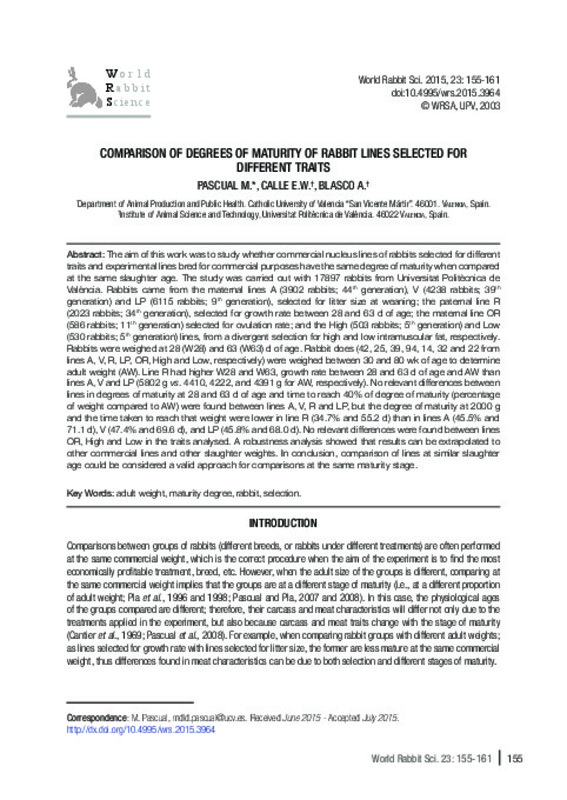JavaScript is disabled for your browser. Some features of this site may not work without it.
Buscar en RiuNet
Listar
Mi cuenta
Estadísticas
Ayuda RiuNet
Admin. UPV
Comparison of degrees of maturity of rabbit lines selected for different traits
Mostrar el registro sencillo del ítem
Ficheros en el ítem
| dc.contributor.author | Pascual, M.
|
es_ES |
| dc.contributor.author | Calle Ayma, Eddy Wilfredo
|
es_ES |
| dc.contributor.author | Blasco Mateu, Agustín
|
es_ES |
| dc.date.accessioned | 2015-12-17T09:22:20Z | |
| dc.date.available | 2015-12-17T09:22:20Z | |
| dc.date.issued | 2015-09-30 | |
| dc.identifier.issn | 1257-5011 | |
| dc.identifier.uri | http://hdl.handle.net/10251/58935 | |
| dc.description.abstract | [EN] The aim of this work was to study whether commercial nucleus lines of rabbits selected for different traits, and experimental lines having commercial purposes, have the same degree of maturity when compared at the same slaughter age. The study was carried out with 17897 rabbits from Universitat Politècnica de València. Rabbits came from the maternal lines A (3902 rabbits; 44th generation), V (4238 rabbits; 39th generation) and LP (6115 rabbits; 9th generation), selected for litter size at weaning; the paternal line R (2023 rabbits; 25th generation), selected for growth rate between 28 and 63 days of age; the maternal line OR (586 rabbits; 11th generation) selected for ovulation rate; and the lines High (503 rabbits; 5th generation) and Low (530 rabbits; 5thgeneration) lines, from a divergent selection for high and low intramuscular fat, respectively. Rabbits were weighted at 28 (W28) and 63 (W63) days of age. Rabbit does (42, 25, 39, 94, 14, 32 and 22 from lines A, V, R, LP, OR, High and Low, respectively) were weighed between 30 and 80 wk of age to determine adult weight (AW). Line R had higher W28 and W63, growth rate between 28 and 63 d of age and AW than lines A, V and LP (5802 g vs. 4410, 4222, and 4391 g for AW, respectively). No relevant differences between lines in degrees of maturity at 28 and 63 d of age and time to reach 40% of degree of maturity (percentage of weight compared to AW) were found between lines A, V, R and LP, but the degree of maturity at 2000 g and the time taken to reach that weight were lower in line R (34.7% and 55.2 d) than in lines A (45.5% and 71.1 d), V (47.4% and 69.6 d), and LP (45.8% and 68.0 d). No relevant differences were found between lines OR, High and Low in the traits analysed. A robustness analysis showed that results can be extrapolated to other commercial lines and other slaughter weights. In conclusion, comparison of lines at similar slaughter age could be considered a valid approach for comparisons at the same maturity stage. | es_ES |
| dc.description.sponsorship | This study was funded by project AGL2014-55921-C2-1-P. The authors are especially grateful to referee A for his/her useful comments. | en_EN |
| dc.language | Inglés | es_ES |
| dc.publisher | Editorial Universitat Politècnica de València | |
| dc.relation.ispartof | World Rabbit Science | |
| dc.rights | Reserva de todos los derechos | es_ES |
| dc.subject | Adult weight | es_ES |
| dc.subject | Maturity degree | es_ES |
| dc.subject | Rabbit | es_ES |
| dc.subject | Selection | es_ES |
| dc.title | Comparison of degrees of maturity of rabbit lines selected for different traits | es_ES |
| dc.type | Artículo | es_ES |
| dc.date.updated | 2015-12-17T09:10:48Z | |
| dc.identifier.doi | 10.4995/wrs.2015.3964 | |
| dc.relation.projectID | info:eu-repo/grantAgreement/MINECO//AGL2014-55921-C2-1-P/ES/ESTUDIO GENOMICO Y METABOLOMICO DE VARIAS LINEAS DE SELECCION DIVERGENTE EN CONEJO: EL CONEJO COMO MODELO EXPERIMENTAL/ | |
| dc.rights.accessRights | Abierto | es_ES |
| dc.contributor.affiliation | Universitat Politècnica de València. Instituto de Ciencia y Tecnología Animal - Institut de Ciència i Tecnologia Animal | es_ES |
| dc.contributor.affiliation | Universitat Politècnica de València. Departamento de Ciencia Animal - Departament de Ciència Animal | es_ES |
| dc.contributor.affiliation | Universitat Politècnica de València. Escuela Técnica Superior de Ingeniería Agronómica y del Medio Natural - Escola Tècnica Superior d'Enginyeria Agronòmica i del Medi Natural | es_ES |
| dc.description.bibliographicCitation | Pascual, M.; Calle Ayma, EW.; Blasco Mateu, A. (2015). Comparison of degrees of maturity of rabbit lines selected for different traits. World Rabbit Science. 23(3):155-161. https://doi.org/10.4995/wrs.2015.3964 | es_ES |
| dc.description.accrualMethod | SWORD | es_ES |
| dc.relation.publisherversion | https://doi.org/10.4995/wrs.2015.3964 | es_ES |
| dc.description.upvformatpinicio | 155 | es_ES |
| dc.description.upvformatpfin | 161 | es_ES |
| dc.type.version | info:eu-repo/semantics/publishedVersion | es_ES |
| dc.description.volume | 23 | |
| dc.description.issue | 3 | |
| dc.identifier.eissn | 1989-8886 | |
| dc.contributor.funder | Ministerio de Economía, Industria y Competitividad | |
| dc.description.references | Ariño, B., Hernández, P., Pla, M., & Blasco, A. (2007). Comparison between rabbit lines for sensory meat quality. Meat Science, 75(3), 494-498. doi:10.1016/j.meatsci.2006.08.013 | es_ES |
| dc.description.references | Baselga M. 2002. Rabbit Genetic Resources in Mediterranean Countries. 1st ed. Options mediterraneenes, serie B: Etudes et recherches, Zaragoza, Spain. | es_ES |
| dc.description.references | Sánchez, J. P., Theilgaard, P., Mínguez, C., & Baselga, M. (2008). Constitution and evaluation of a long-lived productive rabbit line1. Journal of Animal Science, 86(3), 515-525. doi:10.2527/jas.2007-0217 | es_ES |
| dc.description.references | Serrano P., Pascual M., Lavara R., Gómez E. A. 2012. Analysis of management techniques on productivity indicators using the bdcuni Spanish database. In Proc.: 10th World Rabbit Congress, Sharm El Sheik - Egipto. 1: 803-807. | es_ES |
| dc.description.references | Taylor C. S. 1985. Use of genetic size-scaling in evaluation of animal growth. J. Anim. Sci., 61: 118-143. | es_ES |
| dc.description.references | Taylor C. S., Murray J.I. 1987a. Genetic aspects of mammalian growth and survival in relation to body size. In: Academic Press, 1987: 58. | es_ES |








